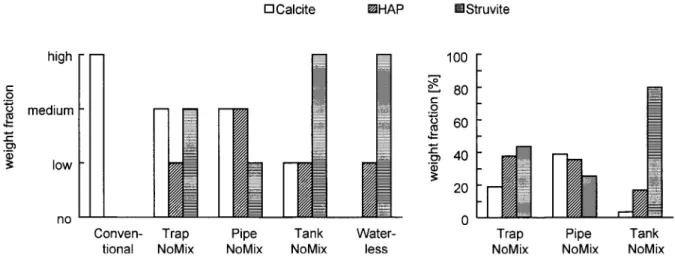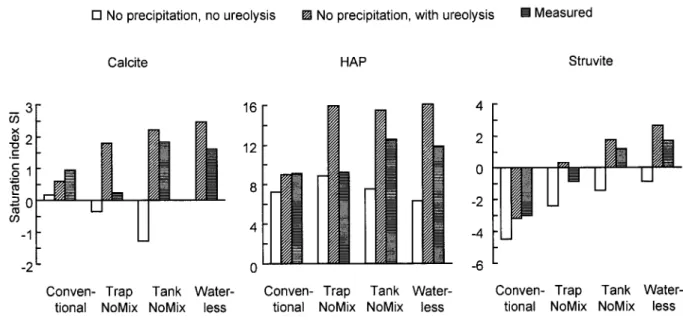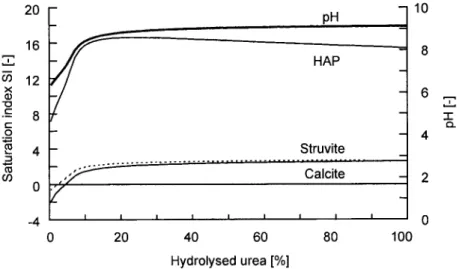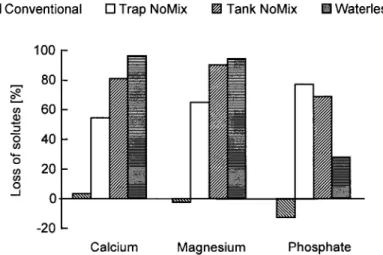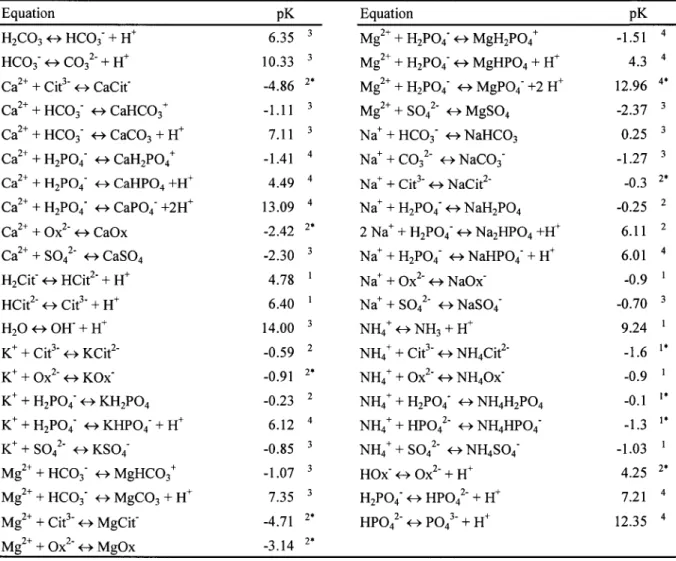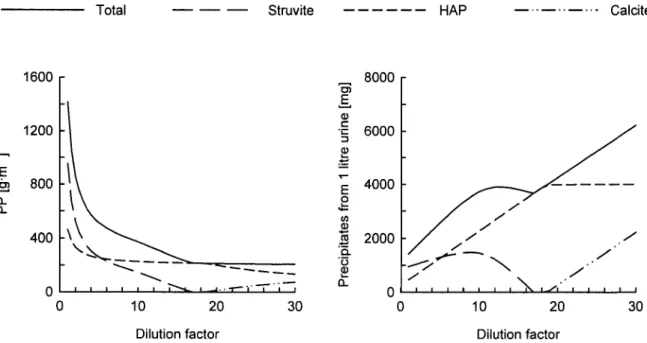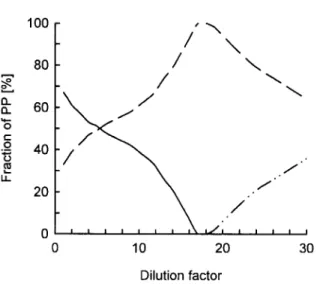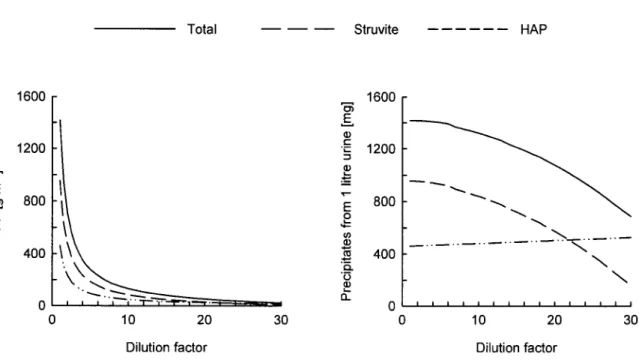First of all, I would like to thank my advisors: Tove Larsen inspired me with new approaches to nutrient management and offered me the opportunity to contribute to this exciting area of research. My colleagues in the office and in the laboratory created a pleasant working atmosphere for me and me. Detailed examination of the NoMix system revealed that urease-positive bacteria grew in the pipes, but not in the collection tank.
Struvite, hydroxyapatite (HAP) and calcite are the only crystalline minerals detected in urine tube encrustations and collection vessel sediment. With increasing tap water dilution, the struvite fraction decreases and calcite becomes an important constituent of the precipitates. Nitrification in activated sludge reactors was stable throughout the experiment.
Die pH-Werte müssen während der Nitrifikation stabil sein, da die Konzentration von Hemmstoffen wie Ammoniak oder Salpetersäure vom pH-Wert abhängt. Die Simulationen zeigten, dass der „Oberflächenversetzungsansatz“ die Ausfällung von Struvit und Calciumphosphat gut beschreiben kann und dass Octacalciumphosphat der Vorläufer von HAP ist.
Biologically Induced Precipitation in Urine-Collecting Systems 9
Estimating the Precipitation Potential in Urine-Collecting Systems 21
Urea Hydrolysis and Precipitation Dynamics in a Urine-Collecting System 39
Fate of Major Compounds in Source-Separated Urine 75
Recovery of Phosphorus and Nitrogen from Source-Separated Urine 83
In the 1970s, urine separation was encouraged in Sweden by the development of modern urine-separating toilets. We measured concentrations in the solutions of the traps and in the urine collection tank to estimate saturation indices. The loss of soluble nutrients was calculated by comparing the estimated initial concentrations with the measured concentrations in the samples.
However, we found different types of deposits in the NoMix tank: hard scales attached to the tank walls, and a viscous sludge on the bottom of the tank (urine sludge). The dilution factors in the waterless urinal and in the NoMix tank had smaller deviations. In the waterless urinal, urine is not flushed and in the NoMix tank the retention time evens out the variations.
A high fraction of soluble phosphate was incorporated into solids in the NoMix trap and tank (Figure 5). This conclusion is supported by the measurements in the low dilution samples, but disagrees with the finding that no calcium, magnesium or phosphate was eliminated in the conventional toilet sample (Figure 5). In the field of urine separation, Hellström et al. 1999) prevented urea hydrolysis in stored source separation urine by lowering the pH with sulfuric acid.
The . total acidity is the amount of protons present in a solution as free ions or bound in a solute.

The total amount of precipitates increased, because tap water supplied additional calcium and magnesium (Figure 1 and Table 3). Over the whole range of simulated dilution
Although precipitation and transformation were still ongoing at the end of the experiments. the maximum mass concentration of precipitates was almost reached. concentration corresponded well to its value at solid-solute equilibrium. This fraction was reached on day 23 and maintained for the remainder of the experiment. the effluent was less than 1% of the total amount of ammonia. Therefore, stable nitrate production requires that the input load of total ammonia and pH in the MBBR only vary in a small range.
Nitritation in the SBR has proven to be very stable with total ammonia concentrations in the influent as high as 2240 gN/m (Table 1). Results in this thesis show that bacterial urease produced in the collecting system produces urea.
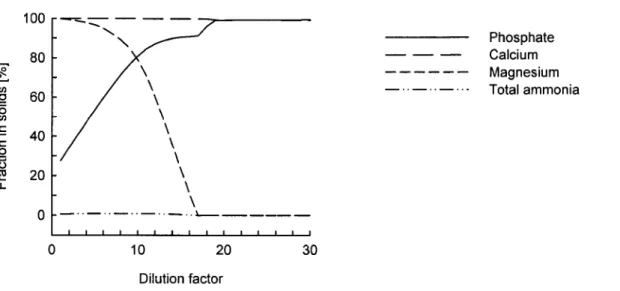
As sulfate reduction in separated urine is likely to occur and may have adverse effects on the urine collection system and human health, sulfate reduction should be the subject of further research. Currently, no data are available on the occurrence of typical sulfate-reducing bacteria in excreted urine, but the conditions for their growth are given. Organic matter is also included in precipitation, as shown in Höglund et al. 2000) found that the concentration of bacteria and or-.
Measurements of fecal sterols in stored urine indicate that transmissible pathogens in separated urine are mainly cross-contaminated by feces (Schönning et al. 2002). Recycling of phosphorus and nitrogen to agriculture is only reasonable under certain conditions. the nutrients must be available to the crops and not lost in the environment. the nutrient concentration of the fertilizer must be high. no chemical or biological fertilizer should seriously affect soil fertility. In Sweden, studies have been conducted into the use of untreated source-separated urine as fertilizer.
Probably only the soluble fraction of the source-separated urine was tested, but not the solid precipitate. The Swiss Federal Research Station for Agroecology and Agriculture (Menzi et al. 1997) estimated that 50% of the total ammonia in liquid manure volatilizes during spreading. There are no experiences with the use of nitrified source-separated urine as fertilizer, but the nitrogen composition indicates good manure quality.
However, to my knowledge, the industrial use of nitrogen from source-separated urine has not been considered so far. Nitrification is a good method to stabilize nitrogen in source-separated urine. volatilization is prevented while a possible fertilizer, ammonium nitrate, is produced. Resource consumption during operation is low, including energy for aeration, agitation and pumping and acid for emergency dosing in case of operational disruptions. Nitrogen elimination from separated urine is possible via partial nitrifi. A beneficial side effect of nitrifying reactors is the oxidation of organic substances.
A strong reduction in buffering capacity is a side effect that may be beneficial for the subsequent use of nitrified urine. they also oxidize substances such as micropollutants and pathogens. Höglund C, Vinnerâs B., Stenström T.A. and Jönsson H. 2000) Changes in chemical and microbial parameters in collection and storage tanks for source separated human urine. Waste design and source control lead to toilet flexibility for sustainable wastewater management.
2001) Kompostierung menschlicher Ausscheidungen durch Verwendung biologischer Trockentoiletten - mit besonderer Berücksichtigung des Kleingarten¬
01 Teaching position at the ETH Zurich
